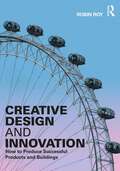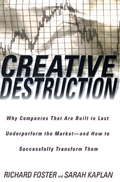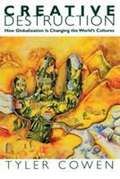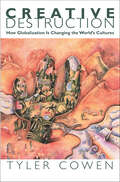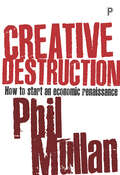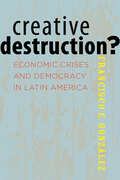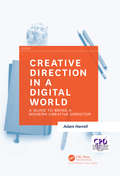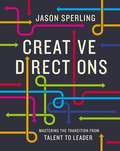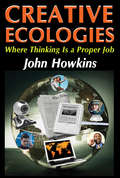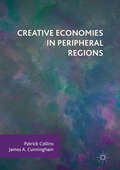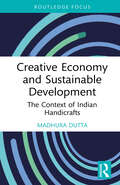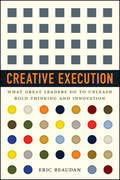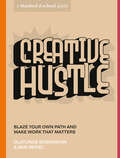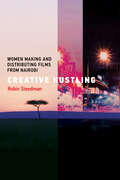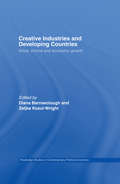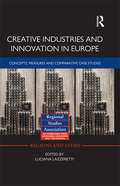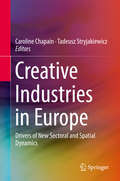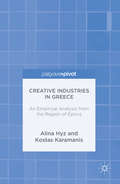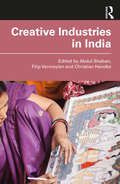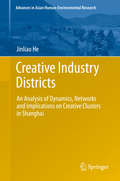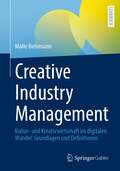- Table View
- List View
Creative Design and Innovation: How to Produce Successful Products and Buildings
by Robin RoyUsing many real-world examples and cases, this book identifies key factors and processes that have contributed to the creation of successful new products, buildings, and innovations, or resulted in some failures. Such factors include the creativity of individuals and groups, their sources of inspiration, the processes of creative design and innovation, and the characteristics of the products, buildings, and innovations themselves. Much has been written about creativity and innovation, but what helps to foster creativity, enable creative ideas to be translated into practical designs, and ensure those new products or buildings succeed as innovations on the market or in use? This book discusses these elements through the author’s origination and analysis of examples and case studies ranging from the revolutionary innovation of the smartphone, through radical innovations in domestic appliances and sustainable housing, to creative designs of contemporary jewellery. The broad range of examples and cases include product and fashion design, filmmaking and fine art, as well as industrial design, engineering, and architecture, offering lessons for creatives, designers, and innovators from many subject backgrounds. Analysis of the different factors, successes, and failures are presented in text boxes throughout the book to allow readers to easily understand the key lessons from each example or case, with numerous colour visuals, diagrams, and charts for illustration. This book is a must-read for a broad audience interested in creativity, design, and innovation, including practitioners in design, engineering, architecture, and product management, and students and instructors of those subjects.
Creative Destruction: From Built-to-last to Built to Perform
by Richard Foster Sarah KaplanTurning conventional wisdom on its head, a Senior Partner and an Innovation Specialist from McKinsey & Company debunk the myth that high-octane, built-to-last companies can continue to excel year after year and reveal the dynamic strategies of discontinuity and creative destruction these corporations must adopt in order to maintain excellence and remain competitive. In striking contrast to such bibles of business literature as In Search of Excellence and Built to Last, Richard N. Foster and Sarah Kaplan draw on research they conducted at McKinsey & Company of more than one thousand corporations in fifteen industries over a thirty-six-year period. The industries they examined included old-economy industries such as pulp and paper and chemicals, and new-economy industries like semiconductors and software. Using this enormous fact base, Foster and Kaplan show that even the best-run and most widely admired companies included in their sample are unable to sustain their market-beating levels of performance for more than ten to fifteen years. Foster and Kaplan's long-term studies of corporate birth, survival, and death in America show that the corporate equivalent of El Dorado, the golden company that continually outperforms the market, has never existed. It is a myth. Corporations operate with management philosophies based on the assumption of continuity; as a result, in the long term, they cannot change or create value at the pace and scale of the markets. Their control processes, the very processes that enable them to survive over the long haul, deaden them to the vital and constant need for change. Proposing a radical new business paradigm, Foster and Kaplan argue that redesigning the corporation to change at the pace and scale of the capital markets rather than merely operate well will require more than simple adjustments. They explain how companies like Johnson and Johnson , Enron, Corning, and GE are overcoming cultural "lock-in" by transforming rather than incrementally improving their companies. They are doing this by creating new businesses, selling off or closing down businesses or divisions whose growth is slowing down, as well as abandoning outdated, ingrown structures and rules and adopting new decision-making processes, control systems, and mental models. Corporations, they argue, must learn to be as dynamic and responsive as the market itself if they are to sustain superior returns and thrive over the long term.In a book that is sure to shake the business world to its foundations, Creative Destruction, like Re-Engineering the Corporation before it, offers a new paradigm that will change the way we think about business.
Creative Destruction: How Globalization Is Changing the World's Cultures
by Tyler CowenA Frenchman rents a Hollywood movie. A Thai schoolgirl mimics Madonna. Saddam Hussein chooses Frank Sinatra's "My Way" as the theme song for his fifty-fourth birthday. It is a commonplace that globalization is subverting local culture. But is it helping as much as it hurts? In this strikingly original treatment of a fiercely debated issue, Tyler Cowen makes a bold new case for a more sympathetic understanding of cross-cultural trade. Creative Destruction brings not stale suppositions but an economist's eye to bear on an age-old question: Are market exchange and aesthetic quality friends or foes? On the whole, argues Cowen in clear and vigorous prose, they are friends. Cultural "destruction" breeds not artistic demise but diversity. Through an array of colorful examples from the areas where globalization's critics have been most vocal, Cowen asks what happens when cultures collide through trade, whether technology destroys native arts, why (and whether) Hollywood movies rule the world, whether "globalized" culture is dumbing down societies everywhere, and if national cultures matter at all. Scrutinizing such manifestations of "indigenous" culture as the steel band ensembles of Trinidad, Indian hand weaving, and music from Zaire, Cowen finds that they are more vibrant than ever- thanks largely to cross-cultural trade. For all the pressures that market forces exert on individual cultures, diversity typically increases within society, even when cultures become more like each other. Trade enhances the range of individual choice, yielding forms of expression within cultures that flower as never before. While some see cultural decline as a half-empty glass, Cowen sees it as a glass half-full with the stirrings of cultural brilliance. Not all readers will agree, but all will want a say in the debate this exceptional book will stir.
Creative Destruction: How Globalization Is Changing the World's Cultures
by Tyler CowenA Frenchman rents a Hollywood movie. A Thai schoolgirl mimics Madonna. Saddam Hussein chooses Frank Sinatra's "My Way" as the theme song for his fifty-fourth birthday. It is a commonplace that globalization is subverting local culture. But is it helping as much as it hurts? In this strikingly original treatment of a fiercely debated issue, Tyler Cowen makes a bold new case for a more sympathetic understanding of cross-cultural trade. Creative Destruction brings not stale suppositions but an economist's eye to bear on an age-old question: Are market exchange and aesthetic quality friends or foes? On the whole, argues Cowen in clear and vigorous prose, they are friends. Cultural "destruction" breeds not artistic demise but diversity. Through an array of colorful examples from the areas where globalization's critics have been most vocal, Cowen asks what happens when cultures collide through trade, whether technology destroys native arts, why (and whether) Hollywood movies rule the world, whether "globalized" culture is dumbing down societies everywhere, and if national cultures matter at all. Scrutinizing such manifestations of "indigenous" culture as the steel band ensembles of Trinidad, Indian handweaving, and music from Zaire, Cowen finds that they are more vibrant than ever--thanks largely to cross-cultural trade. For all the pressures that market forces exert on individual cultures, diversity typically increases within society, even when cultures become more like each other. Trade enhances the range of individual choice, yielding forms of expression within cultures that flower as never before. While some see cultural decline as a half-empty glass, Cowen sees it as a glass half-full with the stirrings of cultural brilliance. Not all readers will agree, but all will want a say in the debate this exceptional book will stir.
Creative Destruction: How to Start an Economic Renaissance
by Phil MullanWestern economies have become stuck in a protracted depression that began long before the 2008 crash. Low productivity, which started in the 1970s, has prevented durable rises in living standards. Phil Mullan shows that the only way to ensure a better future is to create one, calling for a comprehensive economic restructure backed by political and cultural change. This means embracing the uncomfortable disruption involved in progressive change, rekindling in democratic form a spirit of Enlightenment thinking. The votes for Brexit and in the US presidential elections in 2016 indicate that many people desire change, offering greater opportunity for this public discussion. What is needed is a new industrial revolution which develops a broad range of emerging and yet unimagined services and products, provides decent jobs and restores prosperity. Providing examples of the new technologies needed to drive change, backed up by a wealth of data, this important book calls for a sea-change in imagination and thinking.
Creative Destruction?: Economic Crises and Democracy in Latin America
by Francisco E. GonzlezThis illuminating historical study examines the political economies of three Latin American countries in their transition toward democratization.Through most of the twentieth century, financial shocks toppled democratic and authoritarian regimes across Latin America. But things began to change in the 1980s. In this wide-ranging comparative history of Argentina, Uruguay, and Chile, Francisco E. González explains why.Gonzalez examines how these three countries were affected by the Great Depression, Latin America’s 1980s debt crisis, and the late 1990s emerging markets’ meltdowns. He finds that democratic or not, each nation’s regime gained stability in the 1980s thanks to changes in institutions, material interests, economic policies, and other factors. Underlying these developments was a growing ease in the exchange of ideas that created a pro-democracy bias—even in Pinochet’s Chile.With a concluding chapter on the impact of the Great Recession in other Latin American states, Eastern Europe, and East Asia, Creative Destruction? lends insight into the survival of democratic and authoritarian regimes during times of extreme financial instability.
Creative Destruction?: Economic Crises and Democracy in Latin America
by Francisco E. GonzálezThroughout the twentieth century, financial shocks toppled democratic and authoritarian regimes across Latin America. But things began to change in the 1980s. This volume explains why this was the case in Argentina, Chile, and Uruguay.Taking a comparative historical approach, Francisco E. González looks at how the Great Depression, Latin America’s 1980s debt crisis, and the emerging markets' meltdowns of the late 1990s and early 2000s affected the governments of these three Southern Cone states. He finds that democratic or not, each nation’s governing regime gained stability in the 1980s from a combination of changes in the structure and functioning of national and international institutions, material interests, political ideologies, and economic paradigms and policies. Underlying these changes was a growing ease in the exchange of ideas. As the world’s balance of power transitioned from trilateral to bipolar to unipolar, international institutions such as the World Bank and the International Monetary Fund increased crisis interventions that backstopped economic freefalls and strengthened incumbents. Urban-based populations with relatively high per capita income grew and exercised their preference for the stability and prosperity they found as a class under democratic rule. These and other factors combined to substantially increase the cost of military takeovers, leading to fewer coups and an atmosphere friendlier toward domestic and foreign capital investment. González argues that this confluence created a pro-democracy bias—which was present even in Augusto Pinochet’s Chile—that not only aided the states’ ability to manage economic and political crises but also lessened the political, social, and monetary barriers to maintaining or even establishing democratic governance. With a concluding chapter on the impact of the Great Recession in other Latin American states, Eastern Europe, and East Asia, Creative Destruction? lends insight into the survival of democratic and authoritarian regimes during times of extreme financial instability. Scholars and students of Latin America, political economy, and democratization studies will find González's arguments engaging and the framework he built for this study especially useful in their own work.
Creative Direction in a Digital World: A Guide to Being a Modern Creative Director
by Adam HarrellCreative Direction in a Digital World provides designers the tools they need to craft compelling digital experiences across screens, devices and platforms.Readers will learn how to take a multi-disciplinary, human-centered approach to digital creative direction that will help them uncover target audience insights, concept more creative campaigns, change consumer behavior, and create more user friendly digital experiences. <P><P> Divided into ten chapters. Each focuses on a different key aspect of the creative director's job from start to finish. <P><P> Learn how to understand the client's biggest challenges and distill insights about the audience into creative strategies. <P><P> Develop the skills needed to communicate your ideas to a skeptical client. <P><P> Learn how to more effectively manage your creative team. <P><P> And most importantly craft digital experiences that get results.
Creative Directions: Mastering the Transition from Talent to Leader
by Jason SperlingWelcome to the Age of Creatives, where more and more makers, designers, writers, and artists are in demand. Learn how to succeed at managing other creatives … once you understand the new strategies and mindset that are required. For creators, getting that promotion to management is exciting but can also be scary. The skills that made them so successful may not translate to the skill required to be a great manager, and this gets even more complicated when managing other creatives who often don&’t thrive under traditional management procedures.Creative Directions is a management masterclass in which readers attend lectures and seminars as they learn from some of the best in the business, including directors Ava DuVernay (When They See Us) and Joe Russo (Avengers: Endgame); two-time Academy Award-winning editor Angus Wall (The Social Network); executive producers from hit TV shows like The Simpsons and GLOW; and creative directors and leaders at businesses like Amazon, Apple, Disney, TikTok, and more. All of these lessons are provided in an attractive, easily accessible format so that readers can open the book to any page and find some actionable or inspirational insight or strategy.Readers will: Receive essential guidance on how to master the delicate balance required to successfully lead a creative team, like how to relinquish control while keeping the focus where it needs to be.Learn from star creative leaders in the entertainment industry on essential lessons they learned on their path to success.Gain insights on how to balance mastering the new skills you need as a leader with finding the time and energy to focus on the creative work you love.Enjoy the snackable, easy-reference format that makes the lessons easy to implement and apply.
Creative Ecologies: Where Thinking Is a Proper Job (Creative Economy And Innovation Culture Se Ser.)
by John Howkins Bronislaw MalinowskiThe main question of our age is how we live our lives. As we struggle with this question, we face others. How do we handle ideas and knowledge, both our own and those of others? What relationship to ideas do we want? Whose ideas do we want to be surrounded by? Where do we want to think? Most choose, or have the choice made for them, according to what family, colleagues, and friends do and say and what we read about, and a more or less rational calculation of the odds.Modern ecology results from the shift in thinking generated by quantum physics and systems theory, from the old view based on reductionism, mechanics, and fixed quantities to a new view based on holistic systems where qualities are contingent on the observer and on each other. This perception changes how people treat ideas and facts, certainties and uncertainties, and affects both art and science. Worldwide it is part of the process of understanding the current crisis in the environment, and the balance of economy, creativity, and control required in our response.The book's starting point is the growing role that information has played in industrial economies since the 1800s and especially in the last thirty years. It is an attempt to identify ecology of thinking and learning. It is also based on the need to escape from old, industrial ways and become more attuned to how people actually borrow, develop, and share ideas. Throughout the book, Howkins asks questions and offers signposts. He gives no guarantee that creative ecologies will be sustainable, but shows what should be aimed for.
Creative Economies in Peripheral Regions
by James A. Cunningham Patrick CollinsThis is the first study to draw on international research carried out across four EU member states to add to the neglected area of the creative economy of peripheral regions. Economies are dynamic entities and subject to constant flux. Driven by changing tastes, new ways to make and disruptive innovations, new routes of economic development present themselves at ever increasing rates. This study is concerned with the rise of the creative economy. UNCTAD has marked the emergence of the creative economy across the globe and noted its resilience in the face of recent economic turmoil. Here, the authors intend to bring the level of analysis down to the regional and firm level by uncovering the extent of the creative economy in some of Europe's most peripheral regions. This is the first study to draw on international research carried out across four EU member states to add to the neglected area of the creative economy of peripheral regions. The work contributes to expanding theory in the areas of economic geography, business studies and regional development.
Creative Economy and Sustainable Development: The Context of Indian Handicrafts (Routledge Focus on the Global Creative Economy)
by Madhura DuttaThe creative economy is one of the world’s most dynamic sectors. Drawing upon the author’s work on empowerment and sustainability, this book focuses on India's indigenous, rural, traditional handicraft-based creative and cultural industries (CCIs) and the role they can play in the country’s creative economy. The book combines a comprehensive assessment of the region's deeply rooted cultural and creative resources with practical cases of self-sufficient creative skills and knowledge-based entrepreneurship across the Indian handicrafts sector. The author illuminates how sustainability, resilience, and collective well-being, along with unique regional characteristics, are converging towards generating an independent creative and cultural economy that does not depend on global brands and businesses alone. The disconnect between associated policies, practice, and academic work is addressed by contextualizing the case studies in terms of modern economic theory and practice, relevant administrative policies of South Asia, and recognition of the role of culture in achieving the sustainable development goals. This concise yet comprehensive book provides an insightful and holistic understanding of India’s handicrafts economy which will be valuable reading for researchers and reflective practitioners.
Creative Execution
by Eric BeaudanThe ultimate game-changer for reinventing strategy and igniting peopleWhether it was Alexander the Great or Lord Horatio Nelson, the management team at Toyota or Google, the indisputable alchemy of strategy, execution, and leadership led to each's phenomenal success. With years of experience assessing and developing executive talent, author Eric Beaudan examines the essence of such a dynamic mix, summed up as "Creative Execution," showing how organizations and individuals can attain, or reach for, unheralded levels of success.Profiling extraordinary leaders and the uncommon leadership tactics that are their hallmark, the book also includes proprietary research and firsthand experiences with clients across the globe, illustrating the principles of Creative Execution in action.Details the five elements of Creative Execution, including fostering candid dialogue across the organization, spelling out clear roles and responsibilities, and taking bold actionIncludes proprietary research, assessments, and case studiesWith tactics, strategies, and calls to action to help any organization shape and apply the dynamics of Creative Execution, this powerful one-volume manifesto will help any leader get in the trenches, learn firsthand the impact of their decisions, and restore ingenuity, cooperation, and a sense of collective commitment to the workplace.
Creative Genius
by Peter FiskTime and space. Genetics and robotics. Education and fashion. Possibilities limited only by our imaginations. The future is yours to create. Could you be the Leonardo da Vinci of our times? Most ideas are incremental, quickly copied and suffocated by conventions. "Future back" thinking starts with stretching possibilities then makes them a reality "now forward". The best ideas emerge by seeing what everyone has seen, and thinking like nobody else. Newness occurs in the margins not the mainstream. Solutions emerge through powerful fusions of the best ideas into practical, useful concepts. Creative people rise up. Visionaries, border crossers and game changers. Engage your right brain, open your eyes, think more holistically. . . intuition rules. From Apple to Blackberry, GE to Google, innovative companies stand out from the crowd not so much for their exceptional products, despite what one might assume, but for the way they challenge conventions, redefine markets, and change consumer expectations. Apple didn't just create the iPod; it envisioned the future of music and then made a product to service that future. And the same holds true for every highly innovative company. In Creative Genius, Peter Fisk presents ten tracks for innovation and provides business blueprints for making that innovation happen. Creative Genius is inspired by the imagination and perspective of Leonardo da Vinci, in order to drive creativity, design and innovation in more radical and powerful ways. It includes practical tools ranging from scenario planning and context reframing to accelerated innovation and market entry, plus 50 tracks, 25 tools, and 50 inspiring case studies. Creative Genius is "the best and last" in the Genius series by bestselling author Peter Fisk. Others include Business Genius, Marketing Genius and Customer Genius.
Creative Hustle: Blaze Your Own Path and Make Work That Matters (Stanford d.school Library)
by Stanford d.school Olatunde Sobomehin sam seidelA vibrant, illustrated guide to blazing a unique and fulfilling creative path, from the Stanford d.school.Humans have always been creative hustlers—problem solvers who seek to live beyond the limits suggested by society. Yet we live in a world where the place you were born, the amount of money you have, and the level of melanin in your skin indicate the precise path you are expected to follow. Too many of us silence our creativity and let our hustle calcify as we settle for the roles assigned to us. Now Olatunde Sobomehin and sam seidel, co-teachers of the Creative Hustle course at Stanford University, help you identify and navigate your own creative path that leads from your gifts—your unique combination of skills—to your goals, where you make a living doing things that matter. You'll learn about other creative hustlers, like Bryant Terry, who merged his passions for social justice and African American cuisine to become an award-winning eco-chef and cookbook author; Sian Heder, who used her desire to deeply understand herself and others to make award-winning films that add to the cultural conversation; and author/TV host Ayesha Curry, who aligns her professional and personal decisions with her core values. Taking inspiration and lessons from these creative problem-solvers and using activities from the Creative Hustle course, you will begin to see and shape your own path—and follow it to the fulfillment of your goals.
Creative Hustling: Women Making and Distributing Films from Nairobi (Distribution Matters)
by Robin SteedmanThe first book-length study of Nairobi-based female filmmakers—and how their dogged pursuit of opportunities, innovation, and cultural support is defining an industry.Nairobi, the capital of Kenya, is home to something extraordinary and unlikely: in this city, the most critically acclaimed filmmakers—both directors and producers—are women. Yet, across the globe, women make up less than 10 percent of film directors. In Creative Hustling, Robin Steedman takes a closer look at these remarkable women filmmakers, viewing them not only as auteurs, but also as entrepreneurs, who are taking the lead in creating a vibrant, and atypical, screen media industry. To understand their achievement, Steedman theorizes hustling as not only a practice born out of necessity but also an inventive labor in its own right—one that can create new spaces of community by carving new entrepreneurial pathways.Through original empirical field research gathered over eight months in Nairobi, Steedman describes how female filmmakers go about trying to create their films, as well as the challenges they face in distributing those films in their local market. Along the way, she traces the history of the industry over the last fifteen years, the lack of state support for these filmmakers&’ undertakings, the low social standing of the profession, and the transnational conflicts that arise when Euro-American funding is at the heart of Kenyan cinema.Creative Hustling is a major contribution to the task of de-Westernizing media industry studies, imparting important lessons about what it takes to create and distribute creative work in a global age increasingly marked by uncertain work.
Creative Ideas for Solution Focused Practice: Inspiring Guidance, Ideas and Activities
by Judith Milner Steve MyersExploring creative ways to implement solution focused practice, this book is packed full of ideas to inspire ways of working with clients which focus on their strengths as a means to finding solutions. Outlining how and why strengths-based interviewing for solutions is effective, the book provides a wealth of different ways to apply key solution focused techniques. With exercises, sample questions and top tips for tricky situations, the authors show how to apply creative methods in a variety of different settings and with different service user groups. Suitable for use with children and adults, this accessible book will offer exciting ideas for those new to solution focused working as well as more experienced practitioners looking for inspiration.
Creative Industries and Developing Countries: Voice, Choice and Economic Growth (Routledge Studies In Contemporary Political Economy Ser.)
by BarrowcloughPushing the frontiers of the new development paradigm, this book guides debates, clarifies new themes and illustrates how the cultural resources of the developing world can become a new way of integrating into the global economy - helping to raise the voices of developing countries, widening the range of creative choices and promoting cultural diversity and economic and human development. Mixing theory, country case-studies and policy analysis this volume argues that developing countries can use their creative assets and energies as a source of economic growth - if they can better position themselves in the global economy, turning on its head the polarized debate about commerce and culture to take a fresh look at some traditional activities whose intrinsic cultural value has for too long hidden their economic worth. It includes essays from economists, lawyers and industry experts on global trade trends; digital-technology; film in West Africa; audio visuals in India; the music industry in Brazil and the Caribbean; the copyright industry in Arab countries, and policy lessons from developed countries - including sources of finance, subsidies and the role of incubators and intermediaries. Fresh and incisive, this policy lead book on one of the world’s fastest growing sectors is an invaluable resource for to economists and policy-makers alike, as well as those with an interest in industrial organization, development policy, evolutionary economics and the creative industries.
Creative Industries and Digital Transformation in China
by Sabine Chrétien-Ichikawa Karolina PawlikAs China gains momentum in economic terms, its technological transformation, cultural confidence, and creative influence also grow steadily. This book explores socio-cultural context, in which new trends, enabled by the power of digital technology, emerge. Focused on the urban context, in China's large cities like Shanghai, and through the lens of art, design, fashion, gaming, and media industries, this book highlights innovation processes in the making, as well as ongoing shifts in Chinese identities and narratives. This collaborative work written by European authors based in China offer new insights from within. Their shared, yet multi-faceted, engagement with China and its creative industries culminates in this book written for international scholars, students, and industry players.
Creative Industries and Innovation in Europe: Concepts, Measures and Comparative Case Studies (Regions and Cities #57)
by Ron Martin Luciana Lazzeretti Maryann Feldman Gillian Bristow Gernot GrabherIn recent years, the study of creativity has shifted from analysis of culture as an end in itself to one of economic enhancement, and its capability to generate wealth and promote economic development. Increasingly, European cities and regions are using the arts to fuel wellbeing and reinvigorate economies after the comparative demise of more traditional industry and manufacturing. A growing literature is starting to highlight the innovation capacity of cultural and creative industries (CCIs) as they intersect the innovation processes of other manufacturing and services sectors with an innovative and creative output. Culture and creativity may be a strategic weapon to exit the present crisis and redefine an economic model of sustainable development. This book brings together a set of multidisciplinary contributions to investigate the kaleidoscope of European creativity, focussing on CCIs and the innovations connected with them. The two main questions that this volume aims to address are: How can we identify, map and define CCIs in Europe? And how do they contribute to innovation and sustainable growth? The volume is split into two parts. The first part deals with the definition, measurement and mapping of the geography of European CCIs according to a local economic approach, focussing on Italy, Spain, the UK, Austria, Denmark and France. This section surveys the different industrial typologies and spatial patterns, which underline a significant dissimilarity between the North and the South of Europe, mainly due to the difference between heritage-driven and technology-driven countries. The section concludes with a case study on a Japanese creative city. The second part collects some interesting cases of innovation generated in creative spaces such as cities of art or creative clusters and networks. This entails the study of innovations among creative and non-creative sectors (e.g. laser technologies in conservation of works of art and design networks in Italy) and across European and non-European countries (e.g. Spaghetti Western movies in the US or visual artists in New Zealand). Finally, an innovation capacity of culture that can regenerate mature sectors (e.g. the French food supply chain and Swiss watch Valley) or combine the creative and green economics paradigms (e.g. the green creative cities in North Europe) is analyzed. This book will appeal to academics, scholars and practitioners of urban and regional studies, cultural and creative economics and managerial and organization studies.
Creative Industries in Europe: Drivers of New Sectoral and Spatial Dynamics
by Caroline Chapain Tadeusz StryjakiewiczThis book demonstrates how the creative industries are driving new sectoral and spatial dynamics in European cities, regions, and countries, and how these may be influenced by international and global dynamics. It takes a purposeful geographical approach to the study of the creative industries across various Western, Central and Eastern European contexts since the 2008-2009 recession. Despite the growing research looking at the development of the creative industries in the last 15 years, there are still gaps in the coverage of what is happening in Central and Eastern Europe compared to Western Europe. This book addresses these gaps in two parts focusing on particular geographical scales and creative processes: local interplay between sector and space and the role of the creative industries in regional and national economies after the crisis. The book presents original analyses of the post-crisis environment, and novel data on topics such as the role of institutions in the regulation of the fashion industry in global cities, the impact of clustering on film innovation, location patterns of art galleries, regional specialisations and paths of professional carriers in creative industries.
Creative Industries in Greece: An Empirical Analysis from the Region of Epirus
by Alina Hyz Kostas KaramanisAnalyzing the role of creative industries, this book explores regional development within the economic cycle. Using the Greek region of Epirus as an in-depth case study, the authors identify the main opportunities for the region's development as well as the necessary conditions and constraints to achieve future economic growth. The last decade has seen creative industries receive growing attention from researchers, leading to an increasing body of analysis, studies and statistics. Despite this, they remain to be poorly understood and thus underestimated by many societies and policy makers, including those in the Greek economy. Creative Industries in Greece provides a close study of this sector and disseminates its best practices to examine its strengths, weaknesses, threats and opportunities.
Creative Industries in India
by Abdul Shaban Filip Vermeylen Christian HandkeAs digitalization meets local traditions, there is great potential for creative industries (CI) to promote economic and social development in middle- and low-income countries. This book explores the economic and cultural relevance of these industries in India. The book identifies key topics regarding cultural and creative industries in India, which has a rich cultural heritage and a young demographic and is undergoing swift socio-economic change. It contains the most sophisticated and comprehensive mappings of CI in India to date. It also features numerous case studies, which illuminate the growth of CI in India, its intersections with caste and gender, the central role of handloom, handicraft, and other local practices within communities, as well as the specific challenges in safeguarding and harnessing various creative industry assets to promote sustainable development and social change. Rich with empirical data, this book will be an essential read for scholars and researchers of cultural studies, economics, history, social work, development studies, media studies, and South Asian studies.
Creative Industry Districts: An Analysis of Dynamics, Networks and Implications on Creative Clusters in Shanghai (Advances in Asian Human-Environmental Research)
by Jinliao HeSince the late 1990s, there have been broad discussions concerning the rapid rise of the creative economy. Creative or cultural industry is seen as the new engine of the regional growth for both developed economies and emerging nations. At the point of transition in economy and society, China is recently striving to transform its economy from "made in China" towards "created in China". This book provides an insight into creative industries and spaces in Shanghai, which is the fastest growing megacity in China and the center of modern economic development on a global scale. Underpinned by new approaches from economic geography and urban studies, it deals with the new relations between the creative economy and urban environment in Shanghai. Over the last decade, creative clusters have been rapidly emerging in particular locations in the central city of Shanghai. This spatial phenomenon is explained in the book through an analysis of dynamics, networks and implications.
Creative Industry Management: Kultur- und Kreativwirtschaft im digitalen Wandel: Grundlagen und Definitionen
by Malte BehrmannDieses Lehrbuch erklärt die grundlegenden Prinzipien und Definitionen der Creative Industries und beschreibt die Besonderheiten der Kultur- und Kreativwirtschaft. Es erläutert den digital shift anhand zahlreicher Fallbeispiele, z. B. aus der Musik-, Games- und Fernsehbranche, aber auch aus der bildenden und darstellenden Kunst sowie der Modebranche. Im Detail werden die Auswirkungen dieser Veränderungen auf die Wertschöpfungsketten analysiert. Konkrete Anforderungen an das Management in der Kultur- und Kreativwirtschaft nach dem digital shift werden vorgestellt und Themen wie Basisgeschäftsmodelle, Plattformmanagement, Branding, Netzwerkmanagement und Leadership behandelt. Ein Kapitel stellt verschiedene Finanzierungsstrategien vor; abgerundet wird das Buch durch die Beschreibung verschiedener Vertragsstrukturen in den Creative Industries. Das Lehrbuch richtet sich insbesondere an Bachelor- und Master-Studierende aus den Bereichen Kreativwirtschaft, Medien-, Kultur- und Kommunikationsmanagement, aber auch an Gründer und sonstige Interessierte. Kompakte Definitionen der wichtigsten Fachbegriffe, zahlreiche Praxisbeispiele und anschauliche Abbildungen erlauben einen schnellen Zugang zu den einzelnen Themen. Wiederholungs- und Vertiefungsfragen zum Ende jedes Hauptkapitels geben die Möglichkeit, das erlernte Wissen zu reflektieren. Der InhaltBegriff der Creative IndustriesBesonderheiten der Creative Industries im Lichte des digital shiftManagement in der digitalisierten Kultur- und KreativwirtschaftFinanzierungsstrategien für kreative Unternehmer Rechtliche Fragen und Vertragsstrukturen
